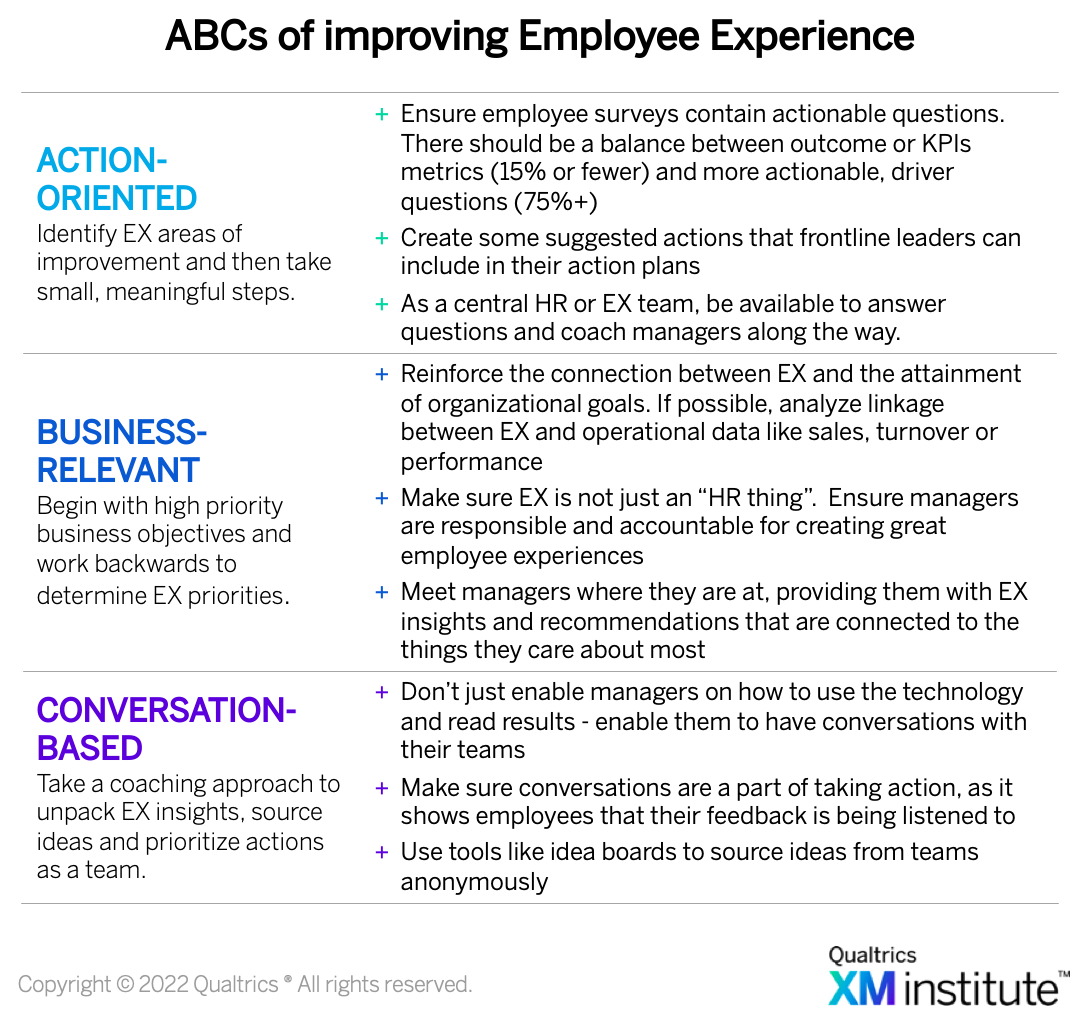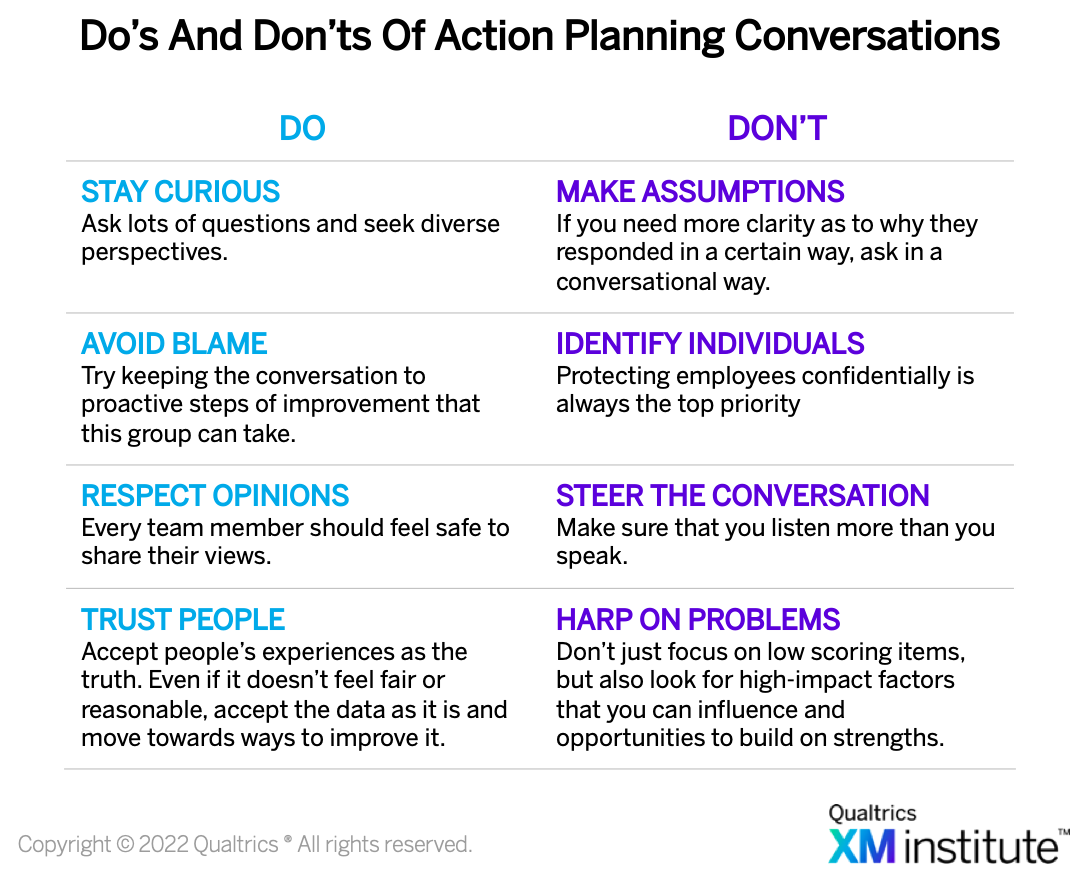“Listen to employees and take action on their feedback.”
Simple, right? This is the message that echoes throughout organizations across the globe. But despite this compelling request, activating frontline managers and leaders to respond to experience insights with their teams remains a persistent and common challenge. Most organizations are great at gathering and disseminating actionable insights, but only 7% of employees agree that their company acts on their feedback really well.
Most managers face increasing pressure in their roles due to the growing complexity and uncertainty in their organizations. While they may wholeheartedly agree that it is important to assess, plan, and act on EX insights, it can be difficult to elevate this work above these more immediate demands on their time. So, how do we make managers’ lives easier? How can we embed this within the normal flow of day-to-day operations?
The ABCs of Effective Manager Action Planning
While employee engagement is a critical prerequisite for strong business performance, finding time to focus on action planning can be hard. We offer a simple ABC framework to help managers respond to EX insights in a way that is action-oriented, business-relevant, and conversation-based. And we know that it’s not easy, so we’ve included advice on how to avoid six common roadblocks.

Manager’s Response: Action-Oriented
When it comes to action planning with your teams, think big, but act small. Look at the big picture and identify employee experiences that need improving, then take small and meaningful steps as a team towards these goals.
There are several common roadblocks that can get in the way of managers and frontline leaders taking action on employee feedback:
- Roadblock #1: Analysis paralysis. When receiving feedback, the full picture may not be clear, so you may hold back on taking action until more is known about the issue. Resist the urge to invest in further analysis of the results, and instead direct this energy towards taking action on the insights available to you, right now. For example, You may discover that well-being is trending down in your team, driven by a sense of belonging. Your immediate response may be to ask analysts for deeper analysis or to conduct focus groups across the organization to learn more. Alternatively, just based on the knowledge that these experiences are connected, you could bring the team together for an action planning session to drive greater belonging + well-being at the team level.
- Roadblock #2: Overemphasizing formal, organization-wide solutions. While system-wide changes are often necessary, this does not absolve you of the responsibility to take action with your teams now. These transformations may take months to gain momentum and you can initiate more immediate actions with your teams in the meantime. If employees give feedback and there is a big delay in seeing its impact, they can begin to disengage. For example, let’s say recognition is an opportunity area on your survey. Buying and implementing a new reward and recognition software platform and creating an enterprise rewards and recognition program is very hard. Setting up a yearly recognition event for one location or department can also be difficult. But making it a point to recognize others is easy. Sitting down and writing one heartfelt handwritten note is very easy and may be more effective than some impersonal program or software.
Manager’s Response: Business-Relevant
Action planning should begin with high-priority business objectives, working backward to determine how employee experience helps or hinders the attainment of these goals. Too often, EX goals and initiatives are presented as a unique set of priorities with an implied or tangential connection to business performance. The absence of a compelling narrative that inspires people to invest in employee experiences ensures that their EX action plans will be deprioritized within the daily flow of work.
Here are two common roadblocks that get in the way of action planning being business-relevant, and ways to overcome them:
- Roadblock #3: EX is viewed as “additional” work. If employee experience focus areas are fighting for space on the priority list, action planning is not going in the right direction. A focus on improving EX should not be positioned as a distraction from other priorities – it is how you achieve them. No matter the business goal or challenge in front of you, it is people that will get you through it. So what do they need to be engaged, productive and efficient, so they can deliver these results? The guidance is in your EX feedback. For example, you may be focused on increasing sales revenue. The most obvious thing may be to double down on sales enablement training. However, employee experience data may indicate that poor technology experiences are creating inefficiencies, as the team is using manual spreadsheets or paper to manage customers. The right pathway would be to invest in new customer relationship management software, save salespeople time and reduce the friction in their workflows, so they can focus on selling and ultimately increase revenue.
- Roadblock #4: Overemphasizing firefighting. What is your burning platform? These are the things that will have dire consequences if they are not remedied. These require ‘firefighting’ to urgently fix the problems that are right in front of you. However, what about the employee experiences that are going well, and if strengthened, could become your competitive advantage? These are the ‘gardening’ activities that nurture the positive features of your culture and enable people to do their best work. When delivering a business-critical strategy, make sure that you also focus on the ‘gardening’ required to get you there. For example, if your company is embarking on a huge digital transformation, learning that the technology team has a low intent to stay is a huge risk that you need to urgently firefight. But also discovering that your organization has a strong customer-centric culture is something you can nurture and connect this transformation back to how it will enable employees to best serve their customers.
Manager’s Response: Conversation-Based
Great action plans are created through conversations with employees. The most effective leaders take a coaching approach to unpack their EX insights, sourcing ideas, and prioritizing actions as a team. They assume that employees are experts in their own experiences, and invite them to share ideas on how to improve them.
- Roadblock #5: Going in unprepared. Make sure not to launch action planning conversations with your team until you take the time to review results and consider them in the context of recent events. Reflect on how improving these experiences might positively impact your team’s performance. Arrive at your team’s action-planning conversation prepared with your focus areas, using their time to source ideas on how to improve these experiences and empower employees to take action. This might only take you a few minutes.
- Roadblock #6: Building an action plan on your own. Too often, action plans are created privately and then shared with teams. Instead, bring your team together for the action planning conversation, where you can source ideas. Start by sharing the insights and your focus areas, then explore actions that can be taken as a team. To facilitate an effective conversation, be aware of some of the Dos and Don’ts in the graphic below.

The 1-2-3 Steps For Following Through On Action Plans
Ultimately, the whole point of asking for feedback is to act on it! Asking for feedback and not acting on it can be more harmful than not asking for feedback at all. Your action planning conversations will surface many great ideas, but focusing on just a few things and doing them really well is far more effective than diluting your efforts across a detailed action plan that does not get delivered. Ensure things get done by keeping it as simple as 123.
- One. Decide one (maybe two) focus areas for your team. Resist the urge to do all the things and prioritize the most important experience gaps in your team.
- Two. Take two relevant actions. Do something that you can act on right away and then follow up and see if it works. Based on the results of that action you can do more or you can pivot into something else.
- Three. Communicate what actions were taken three times, through three different channels. Not everybody checks their email or looks at the employee portal, so make sure it gets mentioned in meetings, in one on one conversations, and through platforms like instant messaging and Slack.
The bottom line: Mobilizing frontline leaders to take action on EX insights is hard work. Keep it as simple as ABC, 123.
Dr. Cecelia Herbert, XMP, PsyD, is a Principal Catalyst for Qualtrics XM Institute
Kevin G. Campbell, MA, ACC, XMP is an Employee Experience Scientist with Qualtrics





